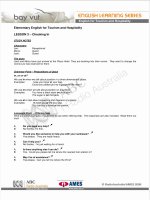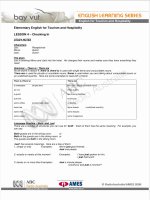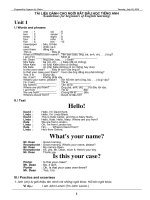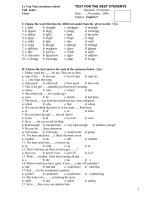English for physics
Bạn đang xem bản rút gọn của tài liệu. Xem và tải ngay bản đầy đủ của tài liệu tại đây (641.83 KB, 22 trang )
<span class='text_page_counter'>(1)</span>nhóm 4 UNIT 4. ELECTRICITY.
<span class='text_page_counter'>(2)</span> READING [1] Electricity is the set of physical phenomena a ssociate with the presence of electric charges We rub objects such as a glass bar, a plastic bar, polyethylene piece,… into wool or silk, they will be able to attract light objects such as pieces of pape r, cotton yards,… We can say that those objects are electrified..
<span class='text_page_counter'>(3)</span> READING In order to understand how the electricity can be pr oducted, we should understand about the change. Atoms are the basic units of matter. They are made up of three kinds of particles: proto ns, neutrons and electrons. .. Fig. 4.1: The electric force between two charges..
<span class='text_page_counter'>(4)</span> READING Protons and neutrons reside in the nucleus. Proton s have a postive (+) charge, neutrons have no char ge - they are neutral. Electrons reside in orbitals around the nucleus. Th e electric charge is usually given the symbol Q. It may be measured in stat-coulomb or in the electr ostatic unit of charge, abbreviated to ESU. Each el ectron carries the same charge of approximately 1,6022. 10-19 coulomb. The proton has a charge t hat is equal and opposite, and thus -1,6022. 10-19 coulomb..
<span class='text_page_counter'>(5)</span> READING [2] As a mentioned above, there are three kinds of particles making up atoms. However, only two ki nds of charges: positive charge (+) and negative c harge (-) can contribute to electricity. A common manifestation of electricity is the repulsi ve or attractive force between two stationary bodie s Like charged objects repel and opposite – charged object attract. ..
<span class='text_page_counter'>(6)</span> READING 1. The force between particles bearing charges q1 an. d q2 can be calculated by Coulomb's law: “The ele ctric force is proportional to the product of charges, divided by the square of the distance that separate s them. The constant of proportionality k is called t he dielectric constant”. = == k.
<span class='text_page_counter'>(7)</span> READING This law is named after the French physicist Charl es Augustin de Coulomb, who developed the equa tion.. Fig. 4.2: The electric field of two charges..
<span class='text_page_counter'>(8)</span> READING [3]A stationary or static charge (Q) creates an elec tric field sorrounding it, and results in a force exert ing on any point by placing a small positive test ch arge +q at that location and observation. We can detect the electric field at any point by plac ing a small positive test charge +q at that location and seeing if it experiences a force. At every point around the charge, (+Q), the positiv e test charge, +q, will experience a force pushing it away..
<span class='text_page_counter'>(9)</span> READING However, for a negative charge, (−Q), the force ve ctors are pulling it toward According to Coulomb’s law, magnitude of electric force decreases when the distance between a test charge (+q) and Q increases Obviously, we need to build a concept specific to t he strength or weakness of electric field at points..
<span class='text_page_counter'>(10)</span> READING 1. That concept is electric field intensity, E. This E at. a point is a specific quantity to the force impact of electric field at that point E at any one point is defined as the force (per unit charge). Because the force is a vector quantity and the char ge is scalar quatity, the electric field intensity is als o a vector quantity = ..
<span class='text_page_counter'>(11)</span> READING It has both magnitude and direction. So, the electri c field intensity from a point charge Q is given by : E=k Q/r2 E points away from the charge if Q is positive char ge and points toward the charge if Q is negative on e).
<span class='text_page_counter'>(12)</span> READING [4]To move a charged particle from one point in th e field to another that requires work. It does not depend on the shape of the way but onl y depend on the positions of the starting and the e nding points of the way. Magnitude of the work to moving the charge from o ne point (A) to another (B) is. � ��=� .� . �.
<span class='text_page_counter'>(13)</span> READING When a charge q moves from one to another in an electric field, the work produces due to the electric force at the potential difference between two points in an electric field. It is specified by the quotient of the work of electric force acting on the charge q in movement from on e to another and the magnitude of q.. � �� � �� = �. It is usually measured by VOLT..
<span class='text_page_counter'>(14)</span> READING [5]In some branches of electrical engineering, elec tric current has been conventionally assumed to flo w in the opposite direction, that is, from positive to negative, called as a conventional current (I) and a lso the direction of electric field (E) If two equally and oppositely charged bodies are c onnected by a metallic conductor such as a wire, t he charges neutralize each other..
<span class='text_page_counter'>(15)</span> READING This neutralization is accomplished by means of a flow of electrons through the conductor from the ne gatively charged body to the positively charged on e.. Fig. 4.3: Two definitions of electric current.
<span class='text_page_counter'>(16)</span> READING In addition, in any continuous system of conductors, electrons will flow from the point of lowest potential t o the point of highest potential in which it opposites t o the conventional current (I). Therefore, in the circuit, the current of positive charg es is moving with the same direction of electric field but the current of electrons is moving with the opposi te direction of electric field or direction of I. A system of this kind electric flow is called an electric current..
<span class='text_page_counter'>(17)</span> READING The current flowing in a circuit is described as direct current (DC) if whose direction and intensity are unc hanged over time and as alternating current (AC) if i t direction is reverses, or alternates, 50 times per se cond in Viet Nam (or 60 times per second in U.S.A).. Fig. 4.4: Direct current and alternating current..
<span class='text_page_counter'>(18)</span> READING [ 6] When charges are in motion which creates the electric current, unlike stationary charge, surroundin g around the moving charges is the magnetic field B. The magnetic field surrounding a current-carrying c onductor can be shown by arranging magnetic com passes around the wire..
<span class='text_page_counter'>(19)</span> READING The compasses line up with the magnetic field produced by the current, a pattern of concentric circles about the wi re. This direction can be determined by using “the right hand grip rule”. When a charge is moving, it experiences a forc e that is proportional to the strength of the magnetic field. This force is known as the Lorentz force and is given by where q is the electric charge of the pa rticle, is⃗ velocity of the particle and B is the magneti ⃗ � =�v .( �the ×⃗ �) c field.
<span class='text_page_counter'>(20)</span> READING This direction can be determined by using “the right hand grip rule”. When a charge is moving, it experie nces a force that is proportional to the strength of th e magnetic field. This force is known as the Lorentz force and is give n by where q is the electric charge of the particle, v is the velocity of the particle and B is the magnetic fi eld.
<span class='text_page_counter'>(21)</span> READING The Lorentz force is always perpendicular to both th e velocity of the particle and the magnetic field that created it. Hence, electric and magnetic effects are caused by the relative position and movement of po sitively and negatively charged particles of matter.. Fig. 4.5: Direction of magnetic field around the current carrying wire..
<span class='text_page_counter'>(22)</span>
<span class='text_page_counter'>(23)</span>









